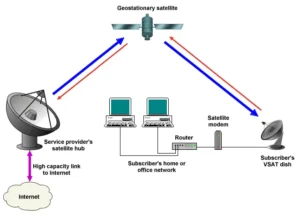Very Small Aperture Terminal (VSAT): Applications, Advantages and Challenges | UPSC
- Context: The Tribal Affairs Ministry is planning to collaborate with the Indian Space Research Organisation (ISRO) to deploy VSAT (very small aperture terminal) stations on a pilot basis for around 80 remote and isolated tribal villages to bring Internet services there.

Analysis
- A very small aperture terminal (VSAT) is a ground station that transmits and receives data from satellites in real-time.
- It utilizes small, compact antennas (usually less than 3 meters in diameter) for transmitting and receiving such data signals.
- This technology has become increasingly popular due to its ability to provide coverage in remote areas where terrestrial networks may not be available.
Characteristics of VSAT
- VSATs exclusively utilize geostationary satellites for communication purposes.
- Satellites in geostationary orbit (GEO) circle Earth above the equator from west to east following Earth’s rotation – taking 23 hours 56 minutes and 4 seconds – by travelling at exactly the same rate as Earth.
- This makes satellites in GEO appear to be ‘stationary’ over a fixed position.
- GEO is used by satellites that need to stay constantly above one particular place over Earth, such as telecommunication satellites.
- This way, an antenna on Earth can be fixed to always stay pointed towards that satellite without moving.
- VSAT internet is usually capable of and suitable for supporting multiple connected computers concurrently.
Mobile VSATs
- Recently, many emergency responders have moved towards more advanced mobile VSAT technology.
- In mobile VSATs, the underlying technology is the same as regular VSATs: relatively large, specially made dishes that work off geostationary satellites.
Advantages
- Because the ground station is communicating with satellites, there is less infrastructure required to service remote locations.
- VSAT is also independent of local telecommunications networks, making it an ideal system to back up wired systems and reduce business recovery risk.
-
- If the wired network goes down, a business can still go on using the VSAT network.
-
- A VSAT can provide reliable internet connectivity for natural disasters, which would typically take down traditional terrestrial infrastructure.
Applications
- Large banks use VSATs to support automated teller machines (ATMs) and to serve as backup to wired networks.
- The National Stock Exchange (NSE) of India has one of the largest VSAT networks in the world, supporting NSE transactions in areas where wired options are limited or unavailable.
- VSAT networks have a number of commercial applications, including, perhaps most notably, enterprise resource planning (ERP).
-
- The use of VSAT to track inventory was one of the many innovations Walmart pioneered in retail to effectively manage its vast inventory in real-time and reduce delivery costs between the warehouse and stores.
-
Challenges in VAST Communication
| Latency | • Network latency (sometimes referred to as lag) is best described as the delay in the time that data takes to transfer across a network.
• Due to the long distances that signals must travel between satellites and ground terminals, latency is an inherent challenge in communications via VAST. |
| Spectrum availability and management | • Access to sufficient and appropriate spectrum is crucial for VSAT service providers.
• They must compete with other satellite operators and terrestrial communication services for limited bandwidth. |
| Bad Weather | • The bands used by VSATs – C and Ku – can be adversely impacted by bad weather, including heavy rain, thunderstorms, sandstorms and even thick fog.
• Any tiny particles suspended in the atmosphere can and will impact the radio signals coming to and from a satellite. • The occasional sun outage due to solar radiation can also distort signals from the satellite. |
| Blocked Signals | • Satellite dishes used for VSATs should have a direct line of sight to sky to properly function.
•Buildings and structures, trees, hills, vehicles and even people can block signals if placed in front of satellite dishes. |
| Less Speed | • The upload and download speeds are lesser to most terrestrial based connections. |
References:
- https://newspaceeconomy.ca/2023/04/18/what-is-vsat/
- https://www.investopedia.com/terms/v/vsat.asp#:~:text=A%20very%20small%20aperture%20terminal%20(VSAT)%20is%20a%20two%2D,in%20orbit%20in%20real%2Dtime.
- https://www.hughes.com/resources/insights/technology/innovations-changed-industry-two-way-vsat
- https://www.investopedia.com/terms/v/vsat.asp#:~:text=A%20very%20small%20aperture%20terminal%20(VSAT)%20is%20a%20two%2D,in%20orbit%20in%20real%2Dtime.
- https://www.esa.int/Enabling_Support/Space_Transportation/Types_of_orbits#GEO
- https://log.logcluster.org/very-small-aperture-terminal-vsat#:~:text=The%20bands%20used%20by%20VSATs,to%20and%20from%20a%20satellite.
Practice Questions:
Q. Discuss the key applications of Very Small Aperture Terminal (VSAT) technology in disaster management in India, along with its advantages and challenges. (Answer in 250 words)
